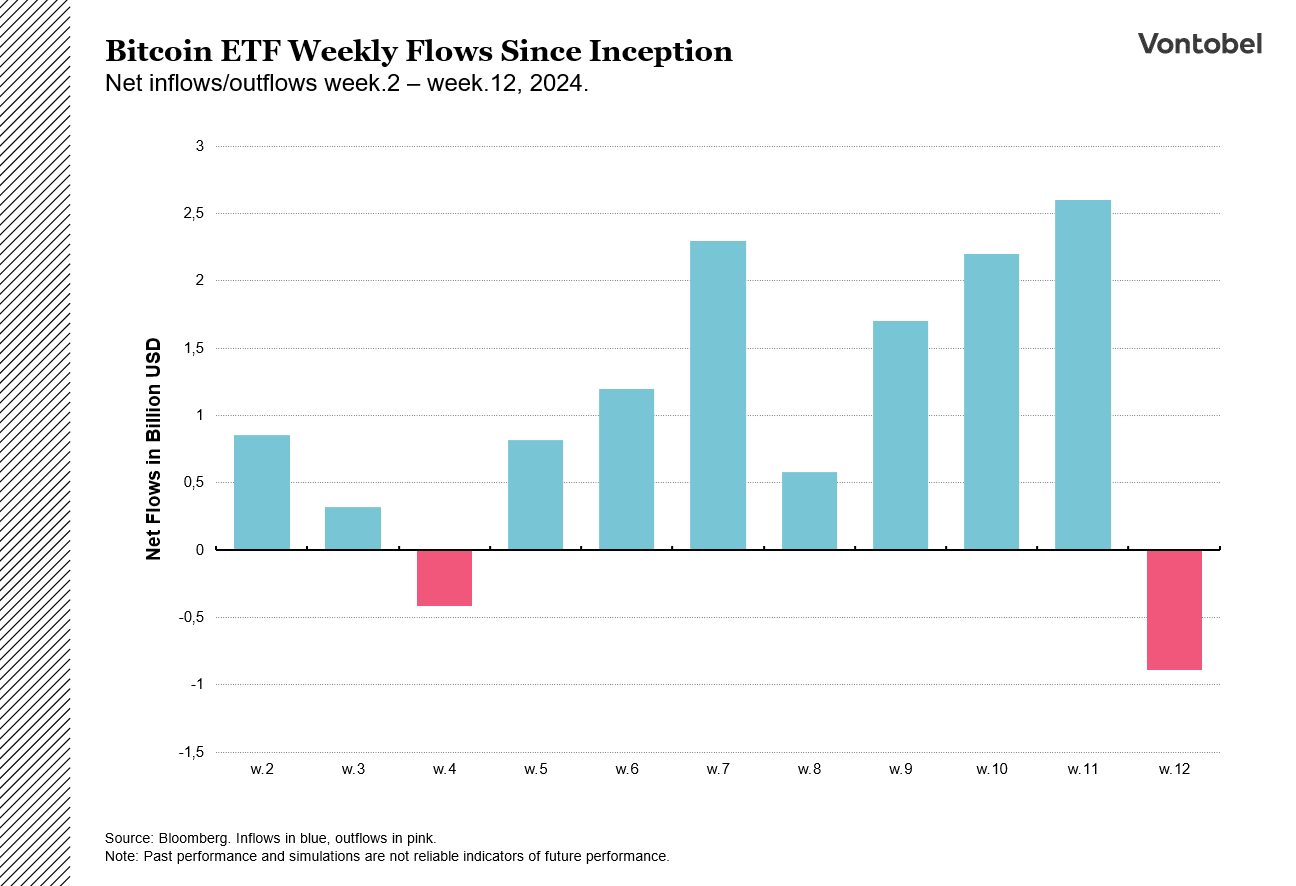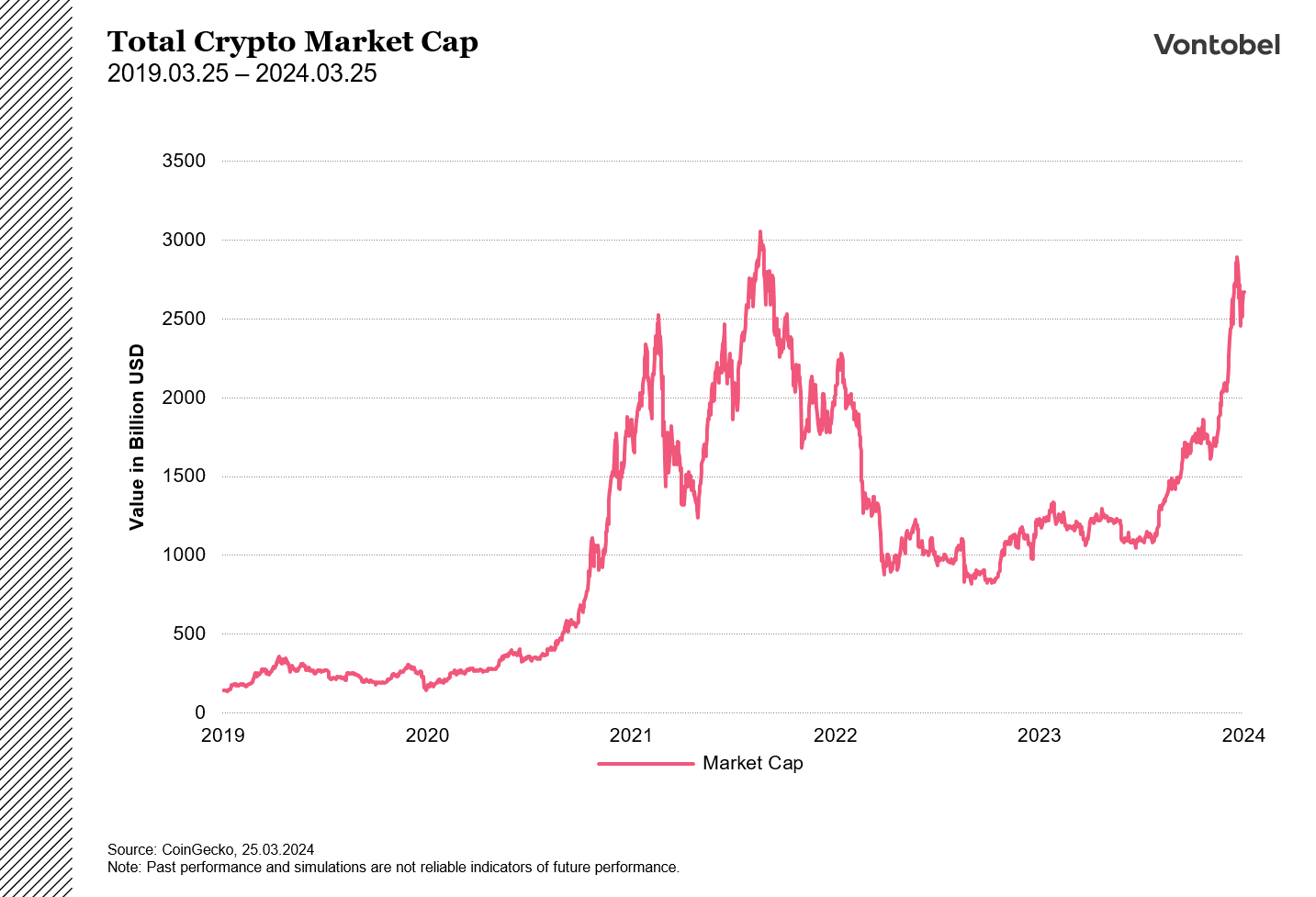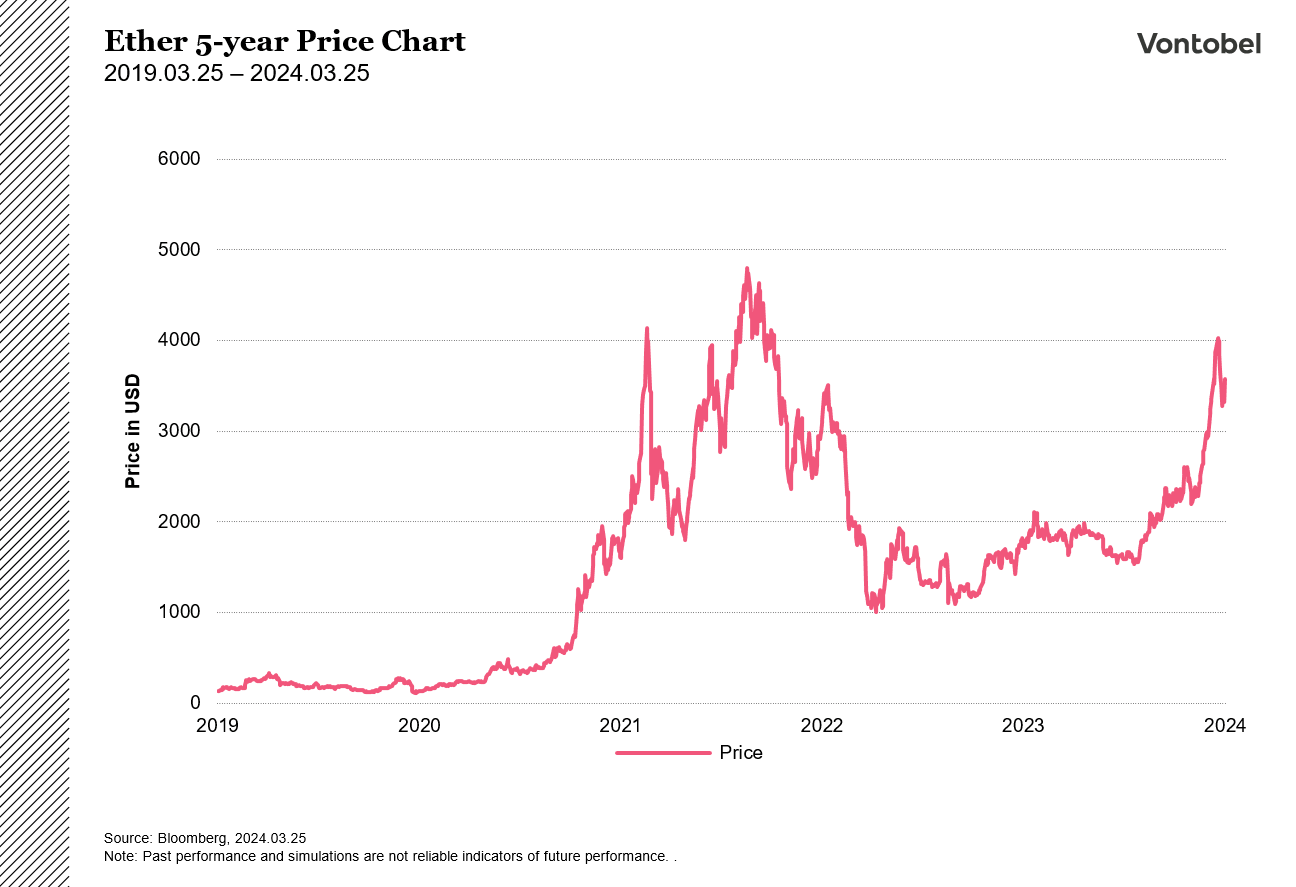Bitcoin Halving and Unexplored Heights

It has not escaped anyone's notice that cryptocurrencies as an asset class have developed strongly in 2024. Bitcoin, the world's largest cryptocurrency in terms of outstanding market cap, passed its previous peak in USD from 2021 in early March. An important milestone for the cryptocurrency, and a pleasing message for crypto investors who have otherwise had a tough period in recent years. Bitcoin has had a boastful price development of 65 percent so far this year, as of 25 March 2024.
Broad rise - Bitcoin stands out
What is the reason behind the significant rise? Interest from institutions in general, and Bitcoin ETFs in particular. The US Securities and Exchange Commission (SEC) allowed exchange-traded funds (ETFs) to own Bitcoin on 10 January this year. Among other things, the decision meant that Americans can now gain exposure to the cryptocurrency through their occupational pensions, so-called 401(k)s, which is a segment covered by USD 7.4 trillion in total assets according to the global association of regulated funds, the Investment Company Institute. The announcement was followed by large inflows to ETFs, which, all else being equal, is obviously positive for Bitcoin's price development.
So far, the ETFs have seen a net inflow of around USD 11 billion. The catch? The inflows were expected, there was already talk long before about the ETFs' impact on demand before the ETFs were approved. Yesterday's news. Week 12 showed the largest net outflows on a weekly basis so far, with USD 888 million leaving ETFs according to Bloomberg. Not necessarily what many had hoped for.

The next big thing
SSo what will drive the price going forward? Crypto-bulls believe that the next big thing is Bitcoin's so-called halving. Halving does not mean halving the number of Bitcoins, but instead halving the reward Bitcoin miners receive for mining the currency. Miners are an important part of the blockchain, validating transactions and making sure everything is done correctly, and in return they receive Bitcoins themselves as compensation. About every four years, this reward is halved, increasing competition among existing miners. The halving of the number of Bitcoins miners are rewarded with guarantees that the number of Bitcoins will not exceed 21 million in the long run, unlike regular fiat currency such as the USD, which in theory can be printed infinitely.
Positive investors to Bitcoin often point out that the cryptocurrency's price has developed strongly in periods after a halving, however, this has only happened three times before: 2012, 2016 and 2020. Too few occasions to call it statistically significant. With Bitcoin's price close to a high, all previous halvings look like a good buying opportunity. The next halving is expected to occur in mid-April this year.

Not just Bitcoin
Sometimes the focus gets stuck on Bitcoin when talking about crypto, but the fact is that Bitcoin "only" makes up about half of the total crypto market value. Sometimes it's worth considering the other half, which has also performed strongly. The broad crypto market has seen an appreciation over the past 12 months, reaching $2.71 trillion as of 25 March according to CoinGecko. This can be contrasted with the US stock market, whose market capitalisation is USD 55.02 trillion according to Bloomberg. However, unlike both Bitcoin and the US stock market, the crypto's market capitalisation has not passed its peak in 2021.

Little brother or the next #1?
Bitcoin's market share of the total crypto market value amounts to 49.55 percent as of 25 March according to CoinGecko. Ether's (ETH) market share amounts to 15.55 per cent, the second largest cryptocurrency in terms of market cap.
Unlike Bitcoin's Proof-of-Work blockchain, which uses miners to validate transactions, Ethereum uses a different technology. The concept is called Proof-of-Stake and means that participants unlock their cryptocurrency for a certain period to validate transactions, and in return receive a reward in the form of newly minted cryptocurrency. Ether also has no upper limit on the number of "coins" that can be minted, so unlike Bitcoin, the number could theoretically go to infinity.
Ether had a strong period in 2020-2022, where the cryptocurrency strengthened significantly against Bitcoin. What happened next? The third crypto winter hit, a period of weak performance for the broad crypto market. BTC stood strong in relation, and has continued to appreciate against ETH since then. As of 25 March, ETH/BTC stands at 0.0514, down 18.6 percent over the past year

What will drive Ether next? It does not seem to be Ether ETFs, at least not in the near future. Many have speculated whether the US SEC will go the same way as in the case of BTC and approve that ETFs can buy into the cryptocurrency. An announcement is expected on 23 May, where the SEC announces whether the ETH ETFs will be approved. According to, among others, James Seyffart, analyst at Bloomberg, the SEC is expected to come up with a no. One of the reasons for the SEC's scepticism may be the blockchain's technology, Proof-of-Stake. Proof-of-Stake entails liquidity risks as the cryptocurrency is locked up over a certain period, as well as counterparty risks if the staking is done via a third party. No matter what, a no vote on 23 May does not mean that the hope is over, Ether ETFs may well become a reality in the future.

What do you think about the development of cryptocurrencies going forward? Regardless of market sentiment, up or down, you can take a position with our products. You can find them HERE.
Risks
Disclaimer:
This information is neither an investment advice nor an investment or investment strategy recommendation, but advertisement. The complete information on the trading products (securities) mentioned herein, in particular the structure and risks associated with an investment, are described in the base prospectus, together with any supplements, as well as the final terms. The base prospectus and final terms constitute the solely binding sales documents for the securities and are available under the product links. It is recommended that potential investors read these documents before making any investment decision. The documents and the key information document are published on the website of the issuer, Vontobel Financial Products GmbH, Bockenheimer Landstrasse 24, 60323 Frankfurt am Main, Germany, on prospectus.vontobel.com and are available from the issuer free of charge. The approval of the prospectus should not be understood as an endorsement of the securities. The securities are products that are not simple and may be difficult to understand. This information includes or relates to figures of past performance. Past performance is not a reliable indicator of future performance.
© Bank Vontobel Europe AG and/or its affiliates. All rights reserved.
Credit risk of the issuer:
Investors in the products are exposed to the risk that the Issuer or the Guarantor may not be able to meet its obligations under the products. A total loss of the invested capital is possible. The products are not subject to any deposit protection.
Market risk:
The value of the products can fall significantly below the purchase price due to changes in market factors, especially if the value of the underlying asset falls. The products are not capital-protected
Risk with leverage products:
Due to the leverage effect, there is an increased risk of loss (risk of total loss) with leverage products, e.g. Bull & Bear Certificates, Warrants and Mini Futures.
Product costs:
Product and possible financing costs reduce the value of the products.
Currency risk:
If the product currency differs from the currency of the underlying asset, the value of a product will also depend on the exchange rate between the respective currencies. As a result, the value of a product can fluctuate significantly.
